| Eco Bites |
 |
|
Wetland Insects |
 |
|
Insects developed on land and the vast
majority live in the terrestrial
environment, less than 2,000 of the more
than 1 million insect species have
inhabited the aquatic environment. Most
of these live in freshwater, only a
small handful of species are found in
the marine environment – these live only
in the intertidal zone. |
|
Read
more about how insects developed and
about their classification - click here. |
|
Insects are found in every conceivable
liquid environment on earth. They occur
in running water, lakes, stagnant
waters, brine, hot springs, cold glacial
streams, and even in tar pits. However,
the shallow waters of ponds and lakes
offer the most favourable balance of
water temperature, sunlight, dissolved
oxygen, food and living space for
insects. Most species are thus found in
shallow waters, none inhabit deep water
in lakes or the deep sea. |
|
As air breathers, they have developed a
variety of devices to survive under
water. Larvae and nymphs extract oxygen
from the water through their skin and/or
filamentous gills. Larger larvae and
nymphs, and all adults living under
water, have to breathe surface air – to
do this they use a variety of mechanisms
which are prototypes of snorkels,
aqualungs and diving bells. |
 |
|
The importance of insects in the aquatic
environment |
|
Aquatic insects are very important in
the food chain. While only a few insect
species have adapted to the aquatic
environment, those that have done so are
present in very large numbers – that
means a huge biomass of animal matter
available in the food chain in these
systems. |
|
They are found in just about every
conceivable aquatic habitat, often being
the only link between the lowest and
highest trophic levels in that
ecosystem. Many species are nutrient or
energy exporters from one ecosystem to
another – the juvenile stages may live
in a water body where they grow and
accumulate energy, but this energy is
transferred to the terrestrial adult
where it is now available in a different
ecosystem. |
|
Aquatic insects are also good indicators
of water quality. Some groups like
stoneflies and caddis-flies live only in
clear unpolluted water; while others
like chironomids prefer polluted waters.
The presence or absence of certain
groups or species can this be an
indication of the health of an
ecosystem. |
 |
|
Some aquatic insects |
|
Several of the more common aquatic insects
found in our wetlands and rivers are discussed
here – the sixteen groups mentioned here do not all occur in
Rietvlei, but most are probably
represented in the Diep River system or
other rivers in the Western Cape. |
|
|
 |
|
Collembola (springtails) |
|
They are primitive wingless hexapods,
taxonomists now place them in a separate
class, but for the purposes of this
discussion we will include them here.
They often occur in large numbers on the
surface feeding on organic detritus or
vegetation, but most of them live in
moist, damp conditions like leaf mould,
seaweed, etc. They are quite common in
tidal pools along our coastline. |
 |
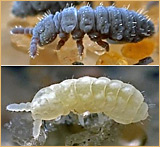 |
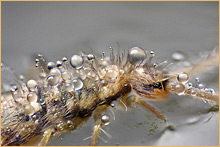 |
| Collembola
on water |
Adult (top)
& instar (bottom) |
Collembola
adult |
|
 |
|
Ephemeroptera (May flies) |
|
The aquatic nymphs are present in large
numbers in quiet waters, mostly feeding
on algae and diatoms, only a few are
predators. They grow quite rapidly,
moulting 20 to 30 times a year. The
adults are terrestrial, they do not feed
and live only from a few hours to a few
days. |
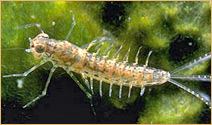 |
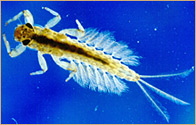 |
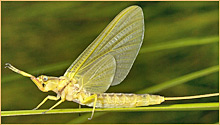 |
| Mayfly
nymph |
Mayfly
nymph |
Mayfly
adult |
|
 |
|
Odonata (dragonflies & damselflies) |
|
The nymphs inhabit lakes, ponds, streams
and marshes, and are ferocious
predators, feeding on small fish,
mosquito larvae and other small aquatic
organisms. The have an extendible lower
jaw to catch prey. The adults live near
water feeding on a variety of insects,
including mosquitoes. |
|
The main visible difference between the
adults is that dragonflies hold their
wings out at rest, while damselflies
fold the wings over their back. |
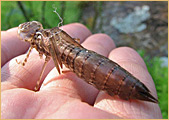 |
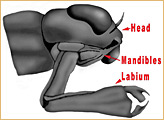 |
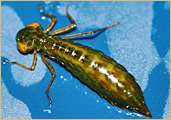 |
| Nymph |
Nymph
mouthparts |
Nymph |
 |
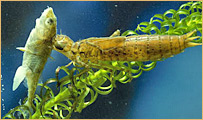 |
 |
 |
| Nymph catch
small fish |
Dragonfly
adult |
Damselfly
adult |
|
 |
|
Plecoptera (stone flies) |
|
Aquatic nymphs are herbivorous, grazing
on algae and plants on the bottom. They
prefer substrates with rocks or stones,
and they are only found in
well-oxygenated water – stonefly larvae
are intolerant of pollution. They can
live for up to 4 years before emerging
as a terrestrial adult. |
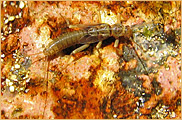 |
 |
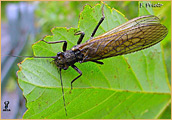 |
| Stonefly
nymph |
Stonefly
nymph |
Stonefly
adult |
|
 |
|
Hemiptera (true bugs) |
|
Corixidae (water boatman).
The herbivorous nymphs live near the
bottom, and the adults also live under
water feeding on aquatic plants and
algae. The adults have to surface to
breathe, they trap a small bubble of air
under the wings before diving down and
feeding near the bottom – their third
pair of legs are shaped like oars to
push them through the water. The adults
often emerge at night, flying to lights
in large numbers. |
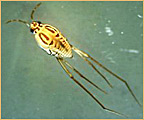 |
 |
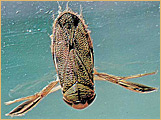 |
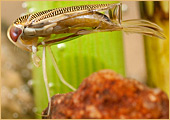 |
| Corixidae
nymph |
Final
nymphal stage |
Water
boatman adult |
Bubble of
air under wings |
|
 |
|
Notonectidae (backswimmers).
Both nymphs and adults are aquatic
predators, the nymphs feed near the
bottom while the adults swim upside down
near the surface. They trap air in
pockets in the abdomen and can stay
submerged for up to 6 hours. They prefer
still lakes, ponds and marshes – the
adults fly well and disperse easily to
new habitats. |
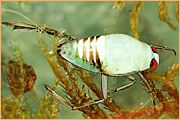 |
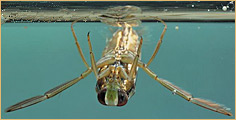 |
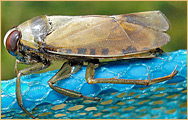 |
| Nymph |
Adult at
surface |
Adult on
land |
|
 |
|
Nepidae (water scorpion).
Nymphs and adults are predators
capturing prey with raptorial forelegs.
The nymphs breathe through abdominal
spiracles, while the adult hangs from
the surface by a long caudal breathing
siphon – diving down to catch prey
swimming in the water. They feed mostly
on invertebrates, but will occasionally
take tadpoles and small fish. |
 |
 |
 |
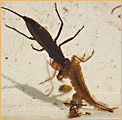 |
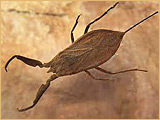 |
| Nymphs and
adult |
Hanging from surface |
Catching
prey |
Adult water
scorpion |
|
 |
|
Gerridae (pond skaters, water striders,
Jesus bugs).
The nymphs live near the bottom and are
carnivorous or omnivorous, feeding on
what is available. The adults live on
the surface of the water, they have long
legs to spread their body weight to be
able to run on top of the water surface.
They are not good fliers, and feed on
insects and zooplankton just under the
surface – the piercing mouthparts will
pierce the prey and suck out the body
fluids. The adults live in large groups,
but are very territorial within the
group. A few species have adapted to the
marine environment and are often seen
skittering along the surface of tidal
pools. |
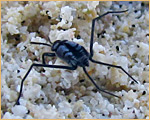 |
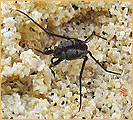 |
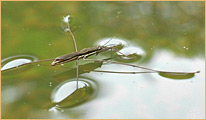 |
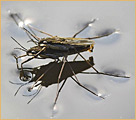 |
|
Nymphs feeding on bottom |
Adult on
surface |
Adults
mating |
|
 |
|
Megaloptera (alderflies, dobsonflies,
fishflies) |
|
The carnivorous larvae feed mostly on
other insects in the water, they grow
slowly taking several years to reach the
last stage when they crawl out onto land
to pupate. The adults are terrestrial,
short-lived and many do not feed at all. |
 |
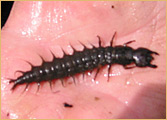 |
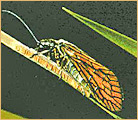 |
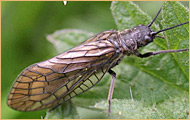 |
| Larva on
bottom |
Larva |
Adult |
Adult |
|
 |
|
Neuroptera (lacewings) |
|
Sisyridae (spongeflies).
Most neuropterans are terrestrial, but
one family, the spongeflies, have
aquatic larvae. The larvae feed on
freshwater sponges and bryozoans,
inserting their mouthparts into the host
and sucking out the cell contents. The
final larval stage spins a net-like
cocoon wherein it pupates. The
terrestrial adults are omnivores and
scavengers. |
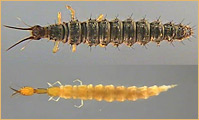 |
 |
 |

 |
| Larvae |
Larva |
Pupa in net |
Spongefly
adults |
|
 |
|
Trichoptera (caddis-flies) |
|
Larvae live in a wide variety of aquatic
environments; many species make
protective cases of silk decorated with
gravel, sand, twigs, bits of leaf, etc.
They prefer clean water and are usually
present in large numbers – the group
include predators, herbivores and algal
grazers. The nocturnal adults are weak
fliers, they are short-lived and do not
feed. |
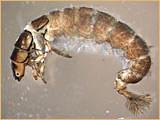 |
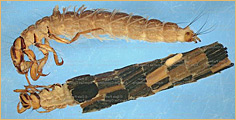 |
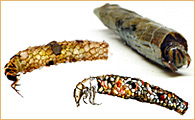 |
|
Caddis-fly larvae and examples
of protective cases |
|
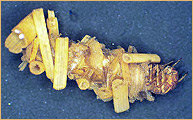 |
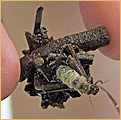 |
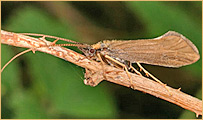 |
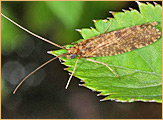 |
|
Larvae in cases |
Caddis-fly adults |
|
 |
|
Coleoptera (beetles) |
|
Gyrinidae (whirligig beetles).
Both larvae and adults are active
pelagic predators. The adults live on
the surface where they usually group in
large numbers, swimming rapidly in
circles when alarmed. They have divided
eyes which can see both above and below
the surface – they trap a bubble of air
beneath the abdomen when diving to feed,
and can stay under water for a long
time. |
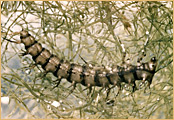 |
 |
 |
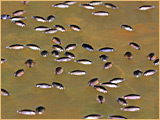 |
| Gyrinid
larva |
Adult |
Adults on surface of pond. |
|
 |
|
Dytiscidae (diving beetles,
water tigers).
The larvae are known as water tigers and
are ferocious predators of tadpoles,
worms, etc. The adults are also
predators, hovering just beneath the
surface and diving down to catch their
prey – they trap a bubble of air under
their carapace when diving. |
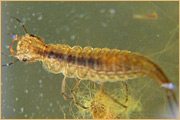 |
 |
 |
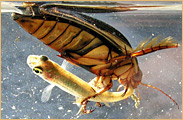 |
 |
| Larva |
Larva |
Adult at
surface |
Adult
catching prey |
Swimming |
|
 |
|
Diptera (true flies) |
|
Chironomidae (chironomids, midges,
muggies).
This is a large family of over 10,000
species, occurring in a wide variety of
aquatic or semi-aquatic environments.
Many species prefer degraded or low
biodiversity ecosystems, and some can
live in virtually anoxic conditions and
are dominant in polluted waters. In some
species the larvae have a haemoglobin
derivative in their body fluids which
extracts oxygen from the water. They
feed on bacteria, diatoms, algae, often
burrowing into the mud and sand of the
bottom of lakes and ponds. Many of the
terrestrial adults do not feed, but
those that do, feed on nectar, pollen,
etc. The adults swarm in large numbers
and clouds of them are often seen near
water bodies. |
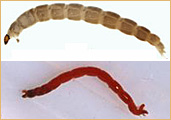 |
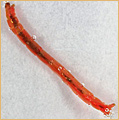 |
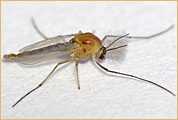 |
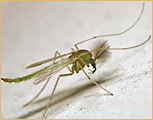 |
|
Chironomid larvae |
Chironomid adults |
|
|
You can
read more about Chironomids on this
website - click here. |
 |
|
Simuliidae (black flies).
The aquatic larvae prefer running water,
anchoring themselves to the substrate
with tiny hooks on the end of the
abdomen, also using silk threads to hold
them in place. They filter organic
particles, algae and bacteria out of the
water with fans around their mouthparts.
They are found in large numbers in
irrigation canals and have spread to
many areas by way of these canals. They
pupate under water, the flying adult
emerging in a bubble of air. While
nectar feeders, the females need a blood
meal for their eggs to develop and they
can range up to 60km from the aquatic
breeding sites in search of a blood
meal. They do spread diseases like river
blindness. |
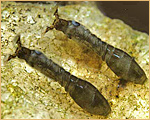 |
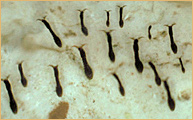 |
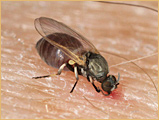 |
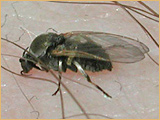 |
|
Larvae attached to bottom - note
fans around mouthparts. |
Blackfly adults females feeding
on blood. |
|
 |
|
Culicidae (mosquitoes).
The larvae inhabit a wide variety of
aquatic habitats, but they prefer
standing water in salt marshes, lakes,
puddles, plants, discarded bottles or
tins, etc. They normally hang from the
surface by a breathing siphon, either
filtering plankton out of the water or
are predators of other small insects.
The adult females need a blood meal for
their eggs to develop, and a few species
are vectors of serious infectious
diseases, like malaria, affecting
millions of people a year. |
 |
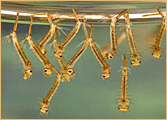 |
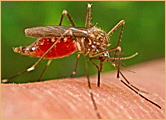 |
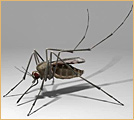 |
|
Mosquito larvae. |
Adult
female feeding |
Adult
mosquito. |
|
|
|
You
can read more about mosquitoes on this
website - click here. |
 |
|
Compiled by Niel van Wyk from various
sources |
 |